Working professionals
Fresh graduates
- Study abroad
- Offline centres
More
27. Columns in Excel
33. Count In Excel
49. Slicers in Excel
54. Solver in Excel
56. Macros In Excel
Remove Blank Rows in Excel: Simple Methods That Work
Do you recall how dazed you first felt when you saw spreadsheets with blank data rows? I have experienced that firsthand. Isn't it a relief when we finally figure out how to declutter those messy Excel sheets?
Excel blank row removal makes a difference, improving the efficiency and manageability of our data activities. With only a few steps, we can tidy up our data quickly and present it in a polished, expert manner.
I'll thus go over several ways and some handy tips and shortcuts on how to remove blank rows in Excel and make working with data a delight. Let’s begin?
Why Removing Empty Rows from Excel is Essential
Let's talk about why Excel removing empty rows is essential. We all love tidy workspaces to streamline and organize our work. Same rule applies to this. Omitting empty rows help tidy your spreadsheets to help in better data management.
Aside from taking up valuable space and making your data more difficult to navigate, those blank rows only impede productivity. By eliminating empty rows, you can simplify and improve the readability, analysis, and also save time sorting through pointless information.
Identifying the Blank Rows
Before removing the blank rows, let me give you some methods to identify blank rows in Excel. Here's a complete explanation of how to efficiently spot blank rows:
Find Those Empty Cells:
- Visual Scanning: Scan the spreadsheet visually for rows with no data. Look for rows where all cells are empty or contain only whitespace characters.
- Use of Navigation Keys: Utilize the arrow keys (up, down, left, right) to browse through the spreadsheet. Pay attention to rows where the pointer goes through cells without visible content.
- Manual Inspection: Manually inspect each row to detect any empty cells. Click on each cell inside a row and see its contents. If a row comprises solely empty cells, it is likely a blank row.
By using the Excel Tool
- Filtering: Excel's filtering functionality can display only rows with empty cells. To do this, choose the data range, navigate to the Data tab, and click the Filter button. Then, use the drop-down arrow in the column headers to filter for blanks.
- Conditional Formatting: Apply conditional formatting to highlight blank rows or cells within the spreadsheet. This makes it easy to visually detect and distinguish blank rows from other data.
- Formulas: Excel formulas can be applied to check for empty cells within a row. For example, the COUNTBLANK function can count the number of empty cells in a row, helping to locate blank rows.
- Visual Basic for Applications (VBA): VBA macros can be built to automate recognizing blank rows for more sophisticated users. Custom VBA scripts can scan over rows and flag or eliminate those having empty cells.
Now, you can easily move with the art of how to remove blank rows in Excel. In addition to this, if you are looking for a holistic introduction to Excel, you can check out beginner-friendly Excel tutorials to get started.
How to Remove Blank Rows in Excel
Removing blank rows in Excel can be done using several approaches, ranging from manual deletion to leveraging built-in Excel features. Let’s check out the two primary methods:
Do it manually:
Step-by-step instructions on How to Remove Blank Rows in Excel manually are below.
Click, delete, repeat:
1. Start by launching the data-containing Excel spreadsheet and navigate to the first blank row that needs to be removed. Select the entire row.

Source: MS Excel
2. Right-click on the row number that you have chosen. Choose the "Delete" option from the context menu. Otherwise, you can use your keyboard's "Delete" key.
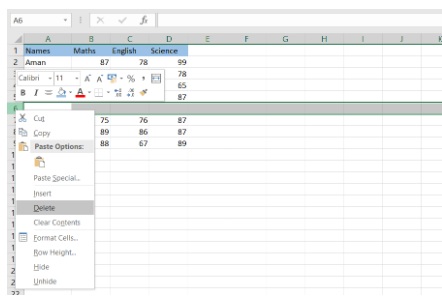
Source: MS Excel
3. Repeat this process for each blank row until all desired blank rows are removed from the spreadsheet.
4. Remove blank rows (Excel), and remember to save your changes.
Use shortcuts for speed:
Step-by-step instructions on how to remove blank rows in Excel using shortcuts are below.
- Instead of right-clicking to delete rows individually, you can apply keyboard shortcuts to accelerate the process.
- Select the row containing the first blank row you want to eliminate.

Source: MS Excel
- Press the "Ctrl" and "-" keys simultaneously to erase the chosen row. This keyboard shortcut is usable in both Windows and Mac versions of Excel.
- Repeat this shortcut for each blank row in the spreadsheet until all desired blank rows are deleted.
- Remember to save your modifications once you've completed deleting the blank rows.
Use Excel's Built-In Features:
Excel includes various options that help eliminate blank rows in Excel, saving time and effort. Step-by-step instructions on how to remove blank rows in Excel using Excel’s built-in features are below.
- Select any cell within your data range. Navigate to the "Data" tab in the Excel ribbon. Click on the "Filter" button. Your data column headings will now have filter arrows.

Source: MS Excel
- In the column where you think there might be blank rows, click the filter arrow. In the dropdown menu, uncheck the box next to "(Blanks)" to filter out any rows with blank cells in that column.
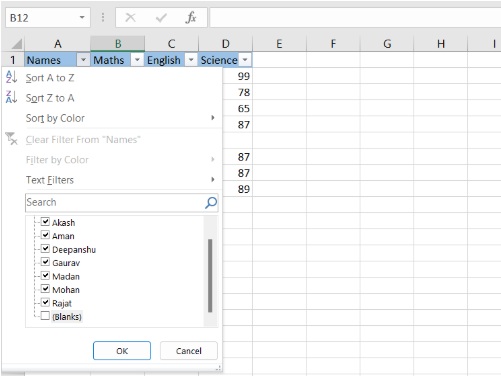
Source: MS Excel
- Finally, click ok. Your blank row will be now removed.
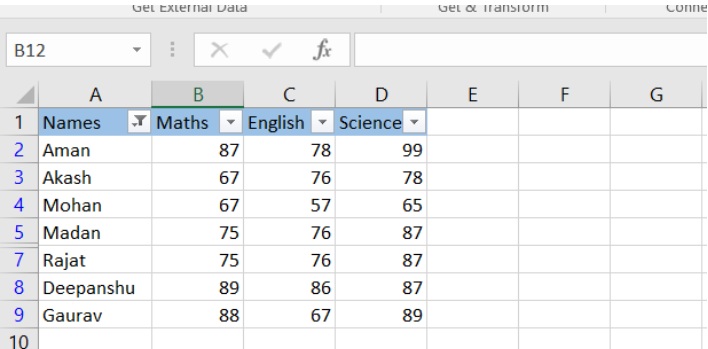
Source: MS Excel
Automated by macros:
When working with massive datasets or for more experienced users, Excel macros provide a robust automated method of eliminating blank rows. Step-by-step instructions on how to remove blank rows in Excel using Macros are below.
- Pressing Alt + F11 on your keyboard will launch the Visual Basic for Applications (VBA) editor first. Or just first enable the developer option in your shortcut tab in Excel by customized ribbon.
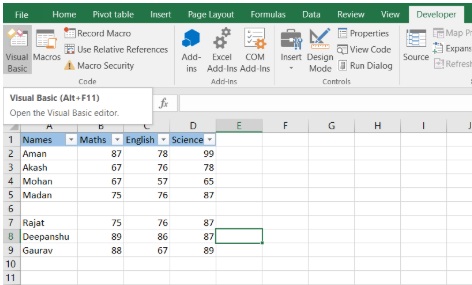
Source: MS Excel
- To add a new module to the VBA editor, click the "Insert" menu and choose "Module."

Source: MS Excel
The following VBA code should be copied and pasted into the module:
Sub RemoveBlankRows()
Dim rng As Range
Dim row As Range
Set rng = ActiveSheet.UsedRange
For Each row In rng.Rows
If WorksheetFunction.CountA(row) = 0 Then
row.Delete
End If
Next row
End Sub
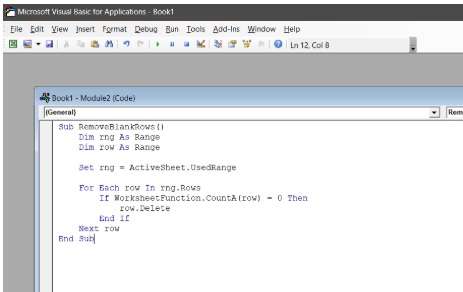
Source: MS Excel
- Close the VBA editor and go back to your spreadsheet in Excel.
- To open the "Macro" dialogue box, press Alt + F8.
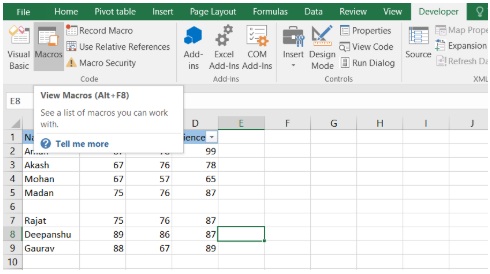
Source: MS Excel
- Click "Run" to start the "RemoveBlankRows" macro after selecting it from the list.
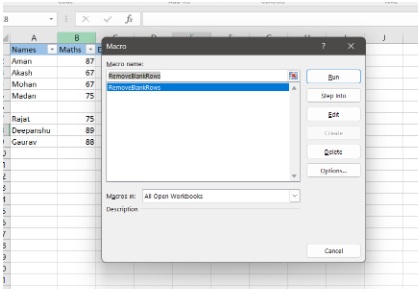
Source: MS Excel
- The macro will automatically scan your data, removing rows with only blank cells.

Source: MS Excel
Your spreadsheet will be free of blank rows after the macro is executed, allowing you to continue your research or additional data manipulation.
Advanced Method for Large Datasets
Arrange before eliminating:
Before removing blank rows, sorting the data can help expedite and improve efficiency, particularly for larger datasets. Step-by-step instructions on how to remove blank rows in Excel using Excel’s advanced features are below.
- First, pick all of the datasets in your Excel workbook.
- Click the "Sort" button after selecting the "Data" tab from the Excel ribbon.
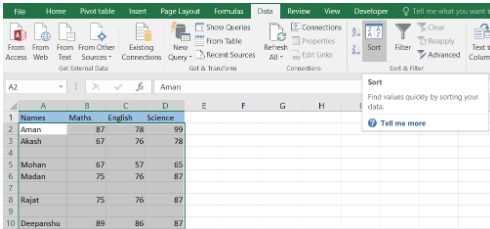
Source: MS Excel
- Select the column that will be used to sort your data. Selecting a column with a lower likelihood of blank cells is frequently beneficial.
- Click "OK" to apply the sort after selecting whether you want the data sorted in ascending or descending order.

Source: MS Excel
- After the data has been sorted, blank rows cluster together, making finding and removing them simpler.

Source: MS Excel
- Use the previously discussed techniques to eliminate the blank rows from the sorted dataset, such as manual deletion or the filtering feature in Excel.
- Remember to save your modifications once you have completed cleaning the data.
Tips and Advice
Lastly, in this section, I'll give you some important tips to enhance your process: How to remove blank rows in Excel.
- Always maintain a backup: Before making any significant changes to your Excel spreadsheet, it's crucial to create a backup copy. This ensures that you have a secure duplicate of your data in case something goes wrong during the editing process.
You can save a backup copy in a different folder or with a different filename to distinguish it from the original. Alternatively, you can use Excel's built-in backup tools or third-party backup solutions to automate the backup process and ensure that your data is always safe.
- Check for errors afterward: After deleting blank rows or making other modifications to your Excel spreadsheet, it's essential to carefully review your work for errors. This includes checking for any unintended changes to the data, such as formatting errors, calculation mistakes, or formula errors.
You can use Excel's auditing features or ask a colleague to review your work for additional feedback. By thoroughly reviewing your work, you can catch and correct any errors before they become bigger problems.
- Automate for efficiency: Excel offers several built-in features, such as Power Query, pivot tables, and macros, that can help you automate time-consuming tasks and increase efficiency.
For example, you can use Power Query to automatically import and transform data from external sources, pivot tables to quickly summarize and analyze large datasets, or macros that automatically remove blank lines (Excel).
Adhering to these best practices and advice ensures that your Excel data management procedures are dependable, accurate, and efficient. I recommend you learn the Top 50 Excel Shortcuts That Will Transform the Way You Work. So, this is how you simplify your data management process by learning how to remove blank rows in Excel.
In summary
In this tutorial, I reviewed the importance of knowing how to remove blank rows in Excel. You could maintain datasets and more efficient work processes by enabling these techniques. Excel offers a range of tools and methods, allowing you to increase productivity and streamline operations related to data management.
Nonetheless, you can visit the upGrad website to learn more about utilizing Excel to its full potential. There are many courses and comprehensive breakdowns of all the features connected to Excel that will help you enhance your Excel skills,
Frequently Asked Questions
1. How do I Delete millions of blank rows in Excel?
Use filtering or macros to delete various blank rows in Excel. You can follow up on the steps in detail by removing blank rows by macros. How do I Delete hidden blank rows in Excel?
2. How do I Delete hidden blank rows in Excel?
To clear empty rows (Excel) that are hidden, first unhide the rows and then delete blank rows in Excel. How do you sort and remove blank rows in Excel?
3. How do you sort and remove blank rows in Excel?
To do so, you need to sort data to group blank rows, then delete them manually. How do you remove empty rows in Excel at the bottom?
4. How do you remove empty rows in Excel at the bottom?
To delete empty rows (Excel), scroll to the bottom, select and delete empty rows in Excel. How do you remove blank rows in Excel on a Mac?
5. How do you remove blank rows in Excel on a Mac?
To remove blank rows (Excel) on Mac, use filtering or macros to remove blank rows. How to remove blank rows in Excel using a formula?
6. How to remove blank rows in Excel using a formula?
To eliminate blank rows in Excel with a formula, apply the formula =IF(COUNTA(A1:Z1)>0,ROW(),"") to identify and remove blank rows in Excel. To eliminate blank rows in Excel with a formula, apply the formula =IF(COUNTA(A1:Z1)>0,ROW(),"") to identify and remove blank rows in Excel. How to remove multiple blank rows in Excel?
7. How to remove multiple blank rows in Excel?
To clear empty rows (Excel) that are multiple, use filtering or macros to remove multiple blank rows in Excel.

Author|15 articles published


upGrad Learner Support
Talk to our experts. We are available 7 days a week, 10 AM to 7 PM
Indian Nationals
Foreign Nationals
Disclaimer
The above statistics depend on various factors and individual results may vary. Past performance is no guarantee of future results.
The student assumes full responsibility for all expenses associated with visas, travel, & related costs. upGrad does not .






















-7f4b4f34e09d42bfa73b58f4a230cffa.webp&w=128&q=75)
-ae8d039bbd2a41318308f8d26b52ac8f.svg)



